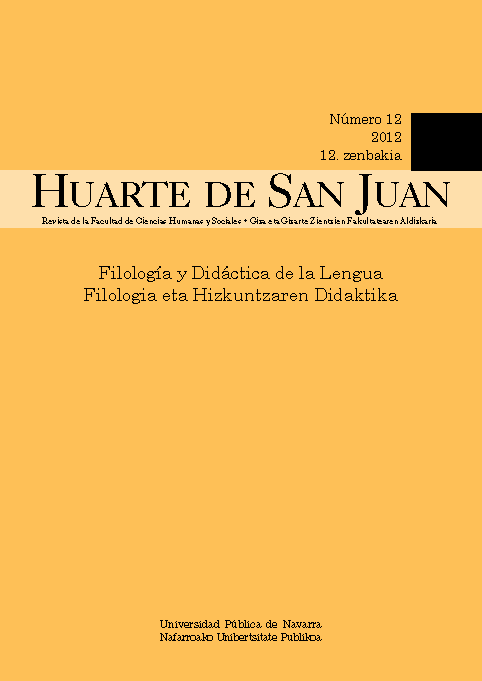Motivación en el aprendizaje de lenguas: estado de la cuestión
Keywords:
Motivation, language learning, modern perspectivesAbstract
This article reviews the different approaches which have been taken in motivation research in language learning from mid last century till nowadays. We focus first on a social-psychological approach, then on a cognitive approach and finally we present more modern perspectives which consider motivation as something qualitatively specific from every language learner.
Downloads
References
Brown, H.D. (1994): Teaching by principles. Eaglewood Cliffs, NJ: Prentice Hall.
Brown, H.D. (2000): Principle of language learning and teaching. New York: Longman.
Clément, R. (1980): “Ethnicity, contact and communicative competence in a second language”, en Giles, H., Robinson, W.P. y Smith, P.M. (eds.), Language: social psychological perspectives. Oxford: Pergamon, pp. 147-154.
Crookes, G. y Schmidt, R. (1991): “Motivation: Reopening the research agenda”, Language Learning, 41, 469-512.
Csizér, K. y Lukács, G. (2010): “The comparative analysis of motivation, attitudes and selves: The case of English and German in Hungary”, System, 38, 1-13.
Deci, E.L. (1992): “The relation of interest to the motivation of behavior: A Self-determination Theory perspective”, en K.A. Renninger, S. Hidi, S. y A. Krapp (eds.), The role of interest in language and development. Hillsdale, NJ: Erlbaum, pp. 43-70.
Dörnyei, Z. (1994): “Motivation and motivating in the foreign language classroom”, The Modern Language Journal, 78, 273-284.
Dörnyei, Z. (2001): Teaching and researching motivation. Harlow: Longman.
Dörnyei, Z. (2005): The psychology of the language learner: individual differences in second language acquisition. Mahwah, NJ: Erlbaum.
Dörnyei, Z. (2009): “The L2 Motivational Self-System”, en Z. Dörnyei y E. Ushioda (Eds), Motivation, language identity and the L2 self. Bristol: Multilingual Matters, pp. 9-42.
Dörnyei, Z. y Csizér, K. (2002): “Motivational dynamics in second language acquisition: Results of a longitudinal nationwide survey”, Applied Linguistics, 23, 421-462.
Dörnyei, Z. y Otto, I. (1998): “Motivation in action: A process of L2 motivation”, Working Papers in Applied Linguistics, 4, 43-69.
Eccles, J.S. y Wigfield, A. (1995): “In the mind of the actor: The structure of adolescents’ achievement task values and expectancy-related beliefs”, Personality and Social Psychology Bulletin, 21, 215-225.
Ehrman, M. (1996): “An exploration of adult language learner motivation, selfefficacy, and anxiety”, en Oxford, R.L. (ed.), Language learning motivation: Pathways to the new century. Honolulu, HI: University of Hawaii, pp. 81-102.
Gardner, R.C. (1985): Social psychology and second language learning: The roles of attitudes and motivation. London: Edward Arnold.
Gardner, R.C. (2006): “The socio-educational model of second language acquisition: a research paradigm”, EUROSLA Year book, 6, 237-260.
Gardner, R.C. y Lambert, W.E. (1972): Attitudes and motivation: Second language learning. Newbury House.
Gardner, R.C. y MacIntyre, P.D. (1991): “An instrumental motivation in language study: Who says it isn’t effective”, Studies in Second Language Acquisition, 13, 57-72.
Hiromori, T. (2009): “A process model of L2 learners’ motivation: From the perspectives of general tendency and individual differences”, System, 37, 313-321.
Markus, H.R. y Nurius, P. (1986): “Possible selves”, American Psychologist, 41, 954-969.
Noels, K.A., Pelletier, L.G., Clément, R. y Vallerand, R.J. (2000): “Why are you learning a second language? Motivational orientations and Self-Determination Theory”, Language Learning, 50, 57-85.
Nunan, D. (1999): Second language teaching and learning. Boston, MA: Heinle & Heinle.
Segal, H.G. (2006): “Possible selves, fantasy distortion, and the anticipated life history: Exploring the role of imagination in social cognition”, en C. Dunkel y J. Kerpelman (eds.) Possible Selves: Theory, Research and Applications. New York: Nova Science, pp. 79-96.
Schumann, J.H. (1986): “Research on the acculturation model for second language acquisition”, Journal of Multilingual and Multicultural Development, 7, 379-392.
Spolsky, B. (1988): “A general theory of second language learning”, TESOL Quarterly, 22, 377-396.
Tremblay, P.F. y Gardner, R.C. (1995): “Expanding the motivation construct in language learning”, The Modern Language Journal, 79, 505-518.
Ushioda, E. (1996): “Developing a dynamic concept of L2 motivation”, en T. Hickey y J. Williams (eds.), Language, education and society in a changing world. Dublin: IRAAL Multilingual Matters, pp. 239-245.
Ushioda, E. (2008): “Motivation and good language learners”, en C. Griffiths (ed.), Lessons from Good Language Learners. Cambridge: Cambridge University Press, pp.19-34.
Ushioda, E. (2009): “A person-in-context relational view of emergent motivation, self and identity”, en Z. Dörnyei y E. Ushioda (eds.), Motivation, language identity and the L2 self. Bristol: Multilingual Matters, pp. 215-228.
Van Lier, L. (1996): Interaction in the Language Curriculum: Awareness, Autonomy and Authenticity. Harlow: Longman.
Williams, M. y Burden, R. (1997): Psychology for language teachers. Cambridge: Cambridge University Press.
Downloads
Published
How to Cite
Issue
Section
License
All articles are published under a Creative Commons (BY-NC-ND 4.0) license. Each article will be assigned a DOI.
Authors retain copyright of their work and grant the journal the right to the first publication. Authors can sign additional agreements to non-exclusive distribution of the published version of the article (for example, in an institutional repository) as long as appropriate attribution to the original publication is provided. Articles can be uploaded to institutional repositories immediately after publication.
Electronic distribution of the articles (for example, academic social networks or personal webpages) is allowed and encouraged.
The journal reserves the right to publicise the work in social networks and other electronic means.







